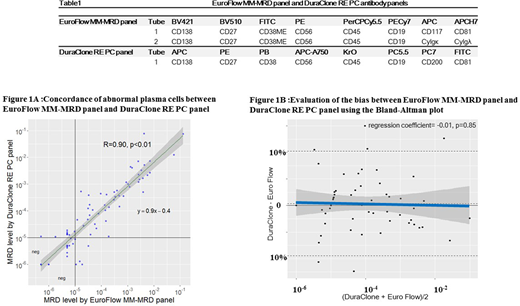Abstract
【Background】The use of novel agents with different mechanisms of action has resulted in high complete response (CR) rates and improved the survival of patients with multiple myeloma (MM). Obtaining minimal residual disease (MRD) negativity following treatment is an important determinant for longer survival in patients with MM. The EuroFlow MM-MRD panel (EuroFlow panel) using the Infinicyt software (Cytognos, Salamanca, Spain) is a two-tube six-color antibody panel. By the addition of two drop-in antibodies (CD138, CD27; vendor of user's choice) into both tubes, an eight-color configuration, which has been validated by the EuroFlow consortium is obtained. The DuraClone RE PC kit (DuraClone panel) is a recently developed one-tube eight-color dry antibody panel using the Kaluza software (Beckman Coulter, Miami, USA) for manual identification of abnormal plasma cells (PCs) to detect MRD in MM. Although both methods are available, a comparison between them has yet to be performed. This study aimed to compare the EuroFlow panel and the DuraClone panel analysis of residual abnormal plasma cells by eight-color flow cytometry.
【Methods】Patients with International Myeloma Working Group defined symptomatic MM treated at Kanazawa University Hospital and Kameda Medical Center in Japan from January 2017 to July 2018 were included. Bone marrow samples were obtained as part of routine clinical practice for evaluating treatment response when appropriate. Bone marrow aspirates (4 mL; first pull of bone marrow aspiration) anti-coagulated with ethylenediamine tetraacetic acid were evenly split (2 mL each) for the EuroFlow panel and the DuraClone panel. PC quantification by the EuroFlow panel was performed at Kanazawa University Hospital and the DuraClone panel was performed at Kameda Medical Center. The monoclonal antibodies used in the EuroFlow and the DuraClone panels are detailed in Table 1. Identification of neoplastic PCs required ≥ 20 cells. Sample processing and measurement of PCs were performed within 48 hours of collection.
The correlation of total leukocyte acquisition, total plasma cells and MRD were analyzed for both methods. Qualitative comparison of MRD negativity was also performed. Spearman's correlation coefficient was used for evaluating the correlation of paired data. The Bland-Altman plot was used for detection of fixed bias and proportional bias.
【Results】A total of 79 samples were analyzed. We first assessed the number of total leukocytes using the EuroFlow panel and the DuraClone panel. The median number of total leukocytes acquired with the EuroFlow panel was significantly higher than with the DuraClone panel (median: 8,505,172 cells, interquartile range [IQR]: 6,164,094 - 9,105,097 cells and median: 2,858,026 cells, IQR: 1,466,004 - 4,284,926 cells, respectively; p < 0.01), but the percentage of total plasma cells showed good concordance between both methods (regression coefficient = 0.91, p < 0.01). The median percentage of abnormal plasma cells was 0.0035% (IQR: 0.0005 - 0.05) and 0.0046% (IQR: 0.0005 - 0.05) using the EuroFlow panel and the DuraClone panel, respectively. Figure 1A shows scatter plots comparing the percentage of abnormal cells analyzed using the EuroFlow panel and the DuraClone panel. Both methods showed a high degree of concordance (regression coefficient = 0.90, p < 0.01). Bland-Altman plots also showed good agreement between both methods. There was no statistically significant fixed bias with a mean difference of 10% (95% confidence interval [CI]: -12~14%). In addition, no significant proportional bias was detected between the two methods (regression coefficient: -0.01, p = 0.85; Figure 1B).
Qualitative analysis of MRD negativity also showed substantial agreement between the two methods (kappa = 0.7); 11 of 79 (13.9 %) samples showed discrepancy for determination of MRD negativity (< 1 × 10-5). Nine of these samples were MRD negative by the EuroFlow panel, but MRD positive by the DuraClone panel, and two samples were MRD positive by the EuroFlow panel, but MRD negative by the DuraClone panel. However, all discrepancies occurred near the limit of detection of both methods (1.0 × 10-5).
【Conclusion】Our findings indicate that the DuraClone panel has good overall concordance with the EuroFlow panel for the detection of abnormal PCs in MM samples. The one-tube DuraClone panel enables to reduce processing time and test cost compared with the two-tube EuroFlow panel.
Takamatsu:Celgene: Honoraria, Research Funding; Janssen: Honoraria; Bristol-Myers Squibb: Research Funding; Ono: Research Funding. Nakao:Alexion Pharmaceuticals, Inc.: Consultancy, Honoraria; Kyowa Hakko Kirin Co., Ltd.: Honoraria; Novartis: Honoraria.
Author notes
Asterisk with author names denotes non-ASH members.


